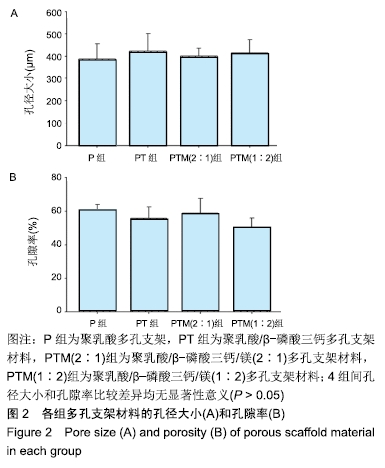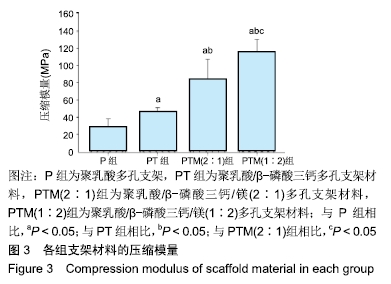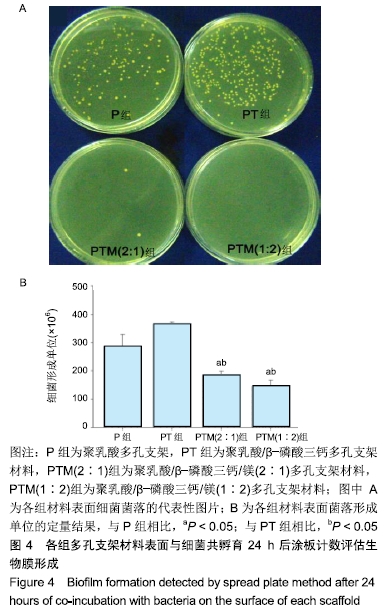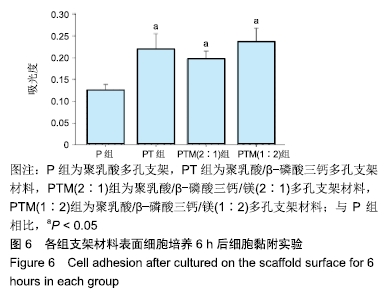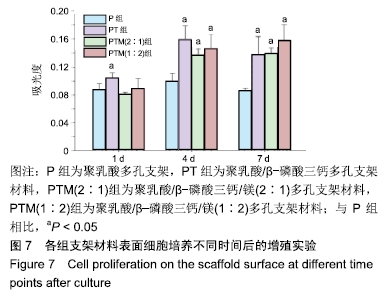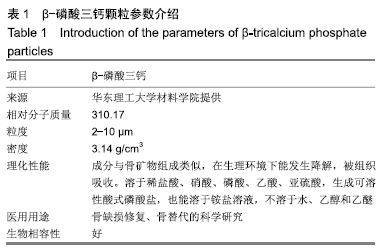中国组织工程研究 ›› 2020, Vol. 24 ›› Issue (22): 3534-3539.doi: 10.3969/j.issn.2095-4344.2272
• 材料生物相容性 material biocompatibility • 上一篇 下一篇
含镁多孔支架材料的体外抗菌活性和生物相容性
马 瑞,王家麟,李永伟,王 伟
- 西安交通大学第二附属医院骨关节外科,陕西省西安市 710004
In vitro antibacterial activity and biocompatibility of a porous scaffold containing magnesium
Ma Rui, Wang Jialin, Li Yongwei, Wang Wei
- Department of Bone and Joint Surgery, the Second Affiliated Hospital of Xi’an Jiaotong University, Xi’an 710004, Shaanxi Province, China
摘要:
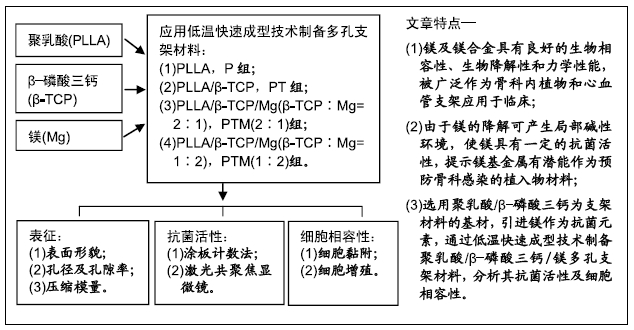
文题释义:
快速成型:是一种材料加工方法,它是在现代CAD/CAM技术、激光技术、计算机数控技术、精密伺服驱动技术及新材料技术的基础上集成发展起来的。不同种类的快速成型系统因所用成形材料不同,成形原理和系统特点也各有不同,但基本原理都是“分层制造,逐层叠加”。
聚乳酸:是以乳酸为主要原料聚合得到的聚合物,具有良好的生物降解性、生物相容性以及延展性,但其机械强度不足,且降解后会产生酸性代谢产物,限制了其应用范围,常与其他一种或多种生物材料复合使用,以增强骨生物活性或生物力学强度。
背景:将多聚物材料与生物陶瓷材料复合制成有机/无机复合三维支架材料,可赋予支架骨传导所必需的理化特性,同时强化材料的力学性能,但大多数骨替代材料无法预防缺损部位的感染。研究发现由于镁的降解可产生局部碱性环境,使镁具有一定的抗菌活性。
目的:探讨含镁多孔支架材料的体外抗菌活性和细胞相容性。
方法:应用低温快速成型技术制备聚乳酸/β-磷酸三钙/镁多孔支架材料,其中β-磷酸三钙与镁的质量比分别为2∶1和1∶2,分别设为PTM(2∶1)组、PTM(1∶2)组;同时应用低温快速成型技术制备聚乳酸与聚乳酸/β-磷酸三钙多孔支架材料,分别设为P组、PT组。检测4组支架的表面形貌、孔径、孔隙率及压缩模量。将金黄色葡萄球菌(ATCC 35923)接种于4组支架表面24 h,通过涂板计数法和激光共聚焦显微镜观察材料的抗菌活性。将小鼠前成骨细胞MC3T3-E1分别与4组支架材料共培养,通过CCK-8法分析材料对细胞黏附和增殖的影响。
结果与结论:①4组支架材料表面都形成相对均匀的多孔结构,4组支架间孔径大小和孔隙率比较差异均无显著性意义(P > 0.05);②PTM(2∶1)组和PTM(1∶2)组压缩模量明显高于P组、PT组(P < 0.05),PTM(1∶2)组明显高于PTM(2∶1)组(P < 0.05);③涂板计数实验显示,PTM(2∶1)组、PTM(1∶2)组菌落形成单位明显低于P组、PT组(P < 0.05),其余组间比较差异无显著性意义(P > 0.05);④培养6 h,PT组、PTM(2∶1)组、PTM(1∶2)组黏附细胞数量多于P组(P < 0.05),PTM(2∶1)组和PTM(1∶2)组比较差异均无显著性意义(P > 0.05);⑤培养1 d时,仅PT组细胞增殖优于P组(P < 0.05);培养4,7 d时,PT组、PTM(2∶1)组、PTM(1∶2)组细胞增殖均优于P组(P < 0.05),PTM(2∶1)组和PTM(1∶2)组比较差异均无显著性意义(P > 0.05);⑥结果表明,聚乳酸/β-磷酸三钙/镁多孔支架材料不但具有良好的抗菌活性,而且具有优良的细胞相容性和一定的抗压能力。
ORCID: 0000-0002-3367-674X(马瑞)
中国组织工程研究杂志出版内容重点:生物材料;骨生物材料; 口腔生物材料; 纳米材料; 缓释材料; 材料相容性;组织工程
中图分类号:

